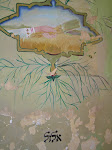Wednesday, December 9, 2009
Original Plaster Walls
We are extremely grateful to Linsly Boyer, our conservation graduate student who is participating in the work, for running a sample of the original plaster walls to determine the composition. She was able to use an XRD-- or x-ray diffraction machine-- at the American Museum of Natural History for this work. XRD uses x-rays to determine the composition of unknown substances. In a (rather simplified) nutshell, the x-rays impinge on the surface of the sample, and are diffracted or bent back towards the machine in different patterns, depending on the arrangement of molecules in the substance. This is a wonderful tool to identify inorganic materials-- which can be extremely important as conservation treatments are planned. We were able to learn that the original white plaster layer is most likely a lime plaster with a small amount of gypsum, which was probably added to help hasten hardening of the wall (or as it is sometimes termed, the plaster was gauged with gypsum). Yet another step towards unraveling the exciting mysteries of the Stanton Street Shul!
Subscribe to:
Post Comments (Atom)
01.jpg)
"Insightful" is the perfect word to describe this wonderful writing of yours. The artistic blend of this subject with your tone of writing made this a great read. Much love 😘.
ReplyDeleteDiaphragm
Sternum
Carpal Bones
Phalanges
Ulna
Radius
Scapula
Humerus
Clavicle